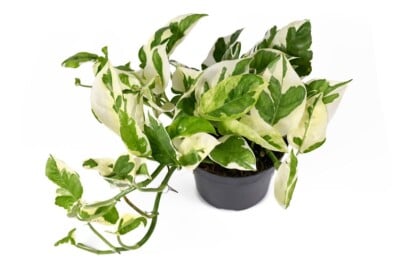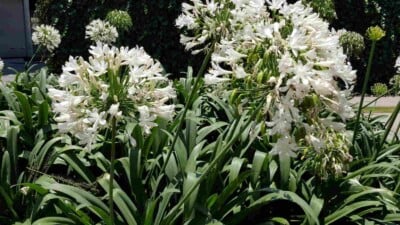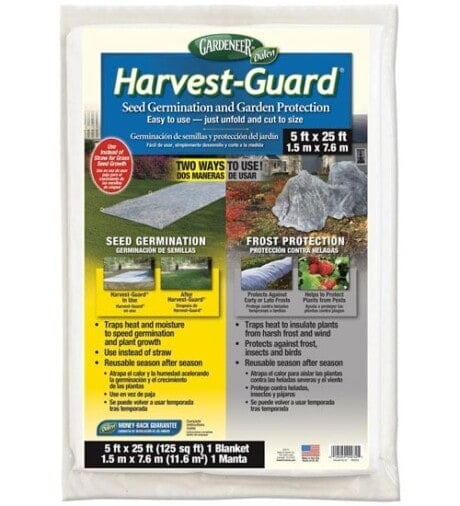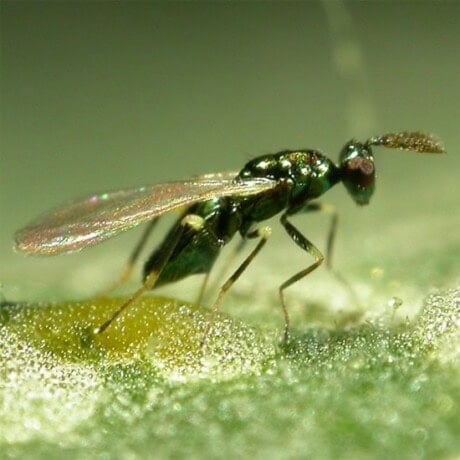Leaf Miner
While not usually threatening to plants, leafminer control is often necessary to manage the highly visible tunnels in leaves that can reduce crop value.
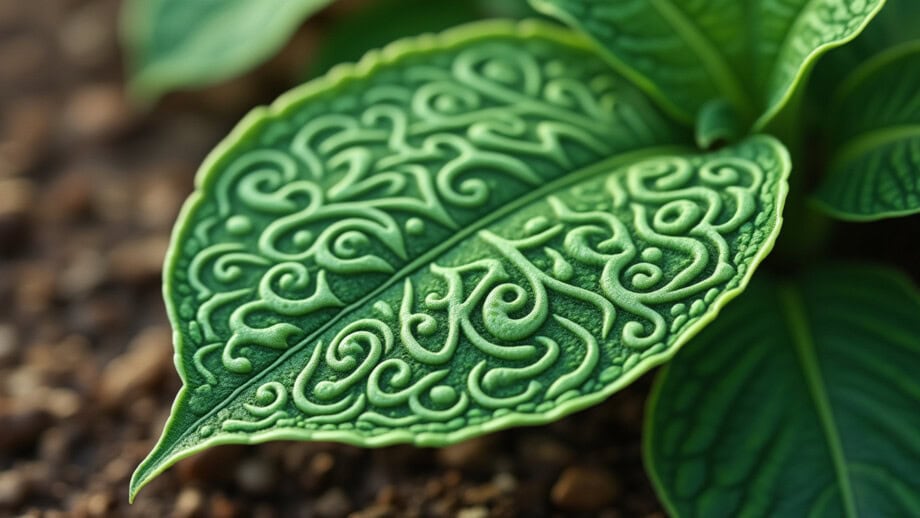
If you have squiggly trails on the leaves of your plants or big blotches of no chlorophyll, you probably have leaf miners. These are the larvae of moths, sawflies, beetles, or flies. The larvae actually live in the leaf, between the outer skin layers. The leaf tissue protects them. Using the principles of Integrated Pest Management (IPM), you can save your potential host plants.
Description of Leaf Miners
Adult leaf miners are tiny moths, sawflies, beetles, or flies. Most people never notice them. Though there are many different leaf miner species, they all have small caterpillars (moths) or maggots (everything else).
The color of the larvae varies from cream, yellowish-green, to green, depending on the species. The larvae are hard to see because they live between the top and bottom cells of the leaf.
The larva feed by chewing or gouging the leaf’s chlorophyll into their mouth. Behind the larva, these gouges leave trails or blotches of opaque or brown tissue damage filled with frass (feces). Sometimes the tracks are squiggly, sometimes they are patches, and sometimes they are both.
Common Leaf Miners
There are too many leaf miner species to name them all. However, these four types of leaf miners are economically important and common in many states.
The spinach leaf miner (Pegomya hyoscyami) has a white, carrot-shaped body with no legs and a head that is not very obvious. The spinach leaf miner fly is only about 1/4 inch. Adult flies are hairy and gray or brown and totally inconspicuous. The larvae feed on many types of vegetables, including spinach, tomatoes, Swiss chard, cucumber, and celery.
The vegetable leaf miner (Liromyza sativae) has a yellow-green cylindrical-shaped larva with no legs or obvious head. The adult is a tiny black and yellow fly only 1/15th inch long. The larvae feed on a wide variety of vegetables, including beans, the deadly nightshade family, cole crops, onions, and beets.
The American serpentine leaf miner (Liriomyza trifolii (Burgess)) is native to the Eastern United States and Canada, the Caribeanine, and southern South America. It has recently been found in California, as well. This small black and yellow fly resembles the vegetable leafminer. This one eats vegetables mainly in tropical and subtropical areas and in greenhouses.
The citrus leaf miner (Phyllocnistis citrella) is from Asia but has been found in Florida since 1993. It has spread west since then. The citrus leafminer is an important pest of citrus trees and related plants. The short-lived moth is 1/4 inch long and light tan. This species rolls a part of the citrus leaf over itself in the pupal stage.
Life Cycle of Leaf Miners
Leaf miners overwinter as pupae in the leaf litter and garden debris. They hatch in early spring when the weather warms. After mating, the adult female gets busy laying eggs on the bottom of leaves, especially new leaves. Old leaves are tougher, and the larva has trouble eating them.
The egg stage is just a few days in warm weather. The larvae hatch from the eggs, chew into the layer between the leaf’s top and bottom and start eating. Some leaf miners live their entire life cycle in one leaf. Others drop to the soil when finished growing and pupate. In most places and with most species, there are multiple generations per year. These can very quickly multiply the number of larvae eating a crop or ornamental plants.
Are leaf miners harmful?
Yes, leaf miners are harmful. They affect the amount of chlorophyll in the leaf, which means it cannot photosynthesize as much energy for the plant. Badly infested leaves can drop off the plant entirely. If too many of the plant’s leaves drop off, it can affect plant growth.
For professional growers, leaf miner damage means edible plants such as spinach are not marketable. Who wants to eat dead tissue filled with frass? Ornamentals with leaf miner damage are also not marketable as they do not look nice.
What causes leaf miners?
Leaf miner damage is caused by the larvae of some moths, flies, sawflies, or beetles. As mentioned above, the adults lay eggs on the underside of leaves. The leaf miner larvae eat the chlorophyll in the plant when they hatch from the eggs. Less chlorophyll in the leaf means less energy for the plant.
How do you get rid of leaf miners?
Leaf miners can be difficult to get rid of because they live between the inside of the leaf. The leaf’s surface shields them from most pesticides. Using Integrated Pest Management (IPM) is your best bet.
In brief, there are three types of control methods in IPM. Cultural controls are things you do to the plants or the environment to control the predators naturally. Biological controls are usually preditors that you release in the affected area so they can eat the problem. Chemical controls use pesticides to kill the problem. They are generally more expensive than cultural or biological controls and worse for the environment.
Cultural Controls
Cultural controls are the preferred method to control leaf miners. They do not hurt the environment as much as chemical controls and are cheaper than buying biological or chemical controls. Many of the cultural control methods are things good gardeners do anyway.
Keep your plants in tip-top condition. This is good advice any time, but if your plants are healthy and thriving, they can better withstand the leaf miner damage. Plants that are barely hanging on are more likely to die if they lose a lot of leaves.
Make sure your plants have enough water, as drought stress can really weaken a plant. By the same token, fertilize the plants as recommended to keep them well fed. Healthy plants can withstand more damage and bounce back faster than stressed plants.
Monitor Your Plants
Check your plants at least weekly. Leaf miners often attack the first true leaves of a plant. Check the bottom of all the plant leaves for eggs, and crush any that you find. If you find leaf miner tunnels on your leaves, squash the larva at the end of the tunnel. You can remove the infected leaves from the plant if the plant has enough other leaves to manage. Do not remove more than 1/3rd of the leaves on any one plant.
Till the Ground
After you remove the last of your fall plants from your garden, till the ground well. This aerates the soil. In addition, tilling will bury and destroy the pupa stage and they will die. This breaks the lifecycle of leafminer and gives your plants a break.
Good Sanitation
Good sanitation will help keep leafminer numbers in check. Keep your garden free of weeds that attract leafminers. Remove leaves and plant debris each season. If you have a few leaves with evidence of leafminers, remove and destroy them.
Do not compost leaves with leaf miners unless you have a very hot compost pile. In that case, bury the plants and leaves in the hottest part of the pile. Otherwise, place them in a plastic bag, seal the bag, and put it in the trash.
Since leaf miners overwinter as pupae, they are not affected by the composting in a cold pile. If you put the infected plants on that kind of compost pile, you will inadvertently spread the pests throughout your garden when you put compost from the pile on the garden beds in the spring.
Decoy Crops
If you have a vegetable garden or a flower bed with expensive plants in it and want to protect them, you can plant things that attract leafminers more than the plants you are trying to protect. Plants such as lamb’s quarter, pigweed, henbane, and nightshade make good decoy patches. Put the decoys close enough to the preferred plants that leaf miners can find them, but off to the side.
If you have a large garden, a border several feet thick of decoy crops can help stop leaf miner damage. The leaf miners will never reach your plants to damage them or, at the very least, there will be less damage.
Row Covers
Row covers provide a physical barrier that prevents the adult leafminers from reaching your plants. A row cover needs to be a cloth such as a cheesecloth that will let in light and rain. This only works if you have had no leafminer problems for a year. Otherwise, the pupae on the ground will hatch inside the row covers, making them worthless.
Crop Rotation
Rotate your vegetables in your garden so you do not plant things leaf miners eat in the same place for at least a year. It makes it harder for the leaf miners to find the crops they like and eat them.
Remember that a vegetable leaf miner will infest almost any leafy greens, so make sure you don’t rotate another green in that spot, even if it is not the same species. For example, don’t plant beets where spinach has been for at least a year.
Biological Controls
Unless there has been widespread indiscriminate spraying in an area, leaf miners should have many natural enemies. If you are having problems with a lack of predators, many organic nursery supply stores stock leaf miner preditors, which you can release in your vegetable garden or flower bed. You will have to tolerate a low level of leafminers or the preditors will starve and won’t be there to help control the problem in the future.
Lacewings
Lacewings are aggressive predators of a wide variety of soft-bodied insects such as aphids, mealy bugs, caterpillars, and scale crawlers. They will remove and eat the leaf miner larva from the leaf. Removing the larva does not heal the leaf miner damage in leaves, but will limit future damage.
Parasitoid Wasps
There are various species of parasitic wasps, but all of them lay eggs in at least one type of leafminer. When the eggs hatch, the larvae start eating the leaf miner from the inside out. When they have finished growing, the larvae chew out of the now-dead leaf miner larva.
You can encourage parasitoid wasps by planting flowers such as dill, fennel, or yarrow that have clumps of flowers with nectar and pollen for the adult wasps to feed on. Make sure you do not spray these plants with any pesticide or you will kill the natural predators on these plants.
Beneficial Nematodes
Beneficial nematodes eat fleas, grubs, cutworms, thrips, bagworms, and leaf miners in the soil. These nematodes are microscopic but are good predators. These are not to be confused with root-knot nematodes, which are pests.
Chemical Control
Chemical control should always be the last resort. Many chemical controls kill beneficial insects such as bees and leaf miner preditors as well as leaf miners. If you must control the leaf miners chemically, use the least toxic option. Apply chemical controls in the evening, after bees and preditors have gone in for the night. You do not want to kill them.
Be sure you follow the instructions as to which vegetables or other plants you can use the control agent on. Some pesticides are systemic, so you cannot use them on leaves you will eat, such as spinach. Make sure you follow the label as to how long you have to wait before you can harvest those vegetables to eat after an application. Pesticides, even organic ones, can make you sick if you eat sprayed plants too soon.
When applying insecticides, wear a long-sleeved shirt, long pants, and close-toed shoes. Some insecticides can be absorbed through the skin. Remember, the label is the law.
Spinosad
Spinosad, sold as Monterey garden insect spray, is derived from soil microbes and does not kill bees or other non-target insects. It just kills the larva. This should be applied at green-up and will have to be reapplied regularly to continue the control. Make sure you coat the top and bottom of the leaves. As the leaf miner chews into the leaf, it consumes the spinosad and gets sick. It then stops feeding and eventually dies.
Pyrethrin
This organic pesticide will kill leaf miners as they leave the egg and enter the leaf. Since they have to chew into the leaf, they ingest the poison with the leaf and die. However, pyrethrin also kills good insects such as bee and leaf miner preditors. Use to spot treat concentrations of leaf miners rather than blanket the whole garden with it. Be sure you get it on the bottom side of the leaf.
What home remedy kills leaf miners?
Many people report successful control of leaf miners by spraying their plants with vegetable oil. The best way to use this is to pour two cups of vegetable oil into a spray container. Mix in two tablespoons of dishwashing liquid. Shake well and spritz on both sides of all the leaves until they have a light coating of oil on them.
This works because the oil covers the leaf miners and prevents oxygen from being absorbed from the skin into their bodies. The leaf miner larvae suffocate and die. This remedy takes time to work, so you may not see results for a few days.
It is a good idea to test this remedy on an inconspicuous leaf of the plant before spraying the whole plant. Neem oil burns the leaves in warm oil. Make sure your mixture doesn’t cause this problem, too.
Leaf miners are the larva of some types of flies, sawflies, beetles, and moths. They lay their eggs on the underside of plant leaves. The larva eats into the leaf when they hatch. They eat the green part of the leaf and leave behind brown trails or blotches. While leaf miners do not usually kill a plant, they damage it cosmetically and usually ruin the marketability of spinach, beet greens, and other vegetables. Nurseries cannot sell ornamental plants with leaf miner trails on them either. Leaf miner larvae are usually kept in check by natural predators. If they are not, you can use Integrated Pest Management to get rid of them.
How to Control
Natural, and organic control methods work best when fighting leafminer problems. That’s because they don’t harm the naturally occurring beneficial insect populations that largely keep the leafminer and other harmful pests under control. While pesticide use can encourage leafminer outbreaks, natural controls and beneficial insects prevent as well as cure these pest problems. Don’t wait until you spot leafminer tunnels in your plants’ leaves, especially if you’ve had problems with them in the past. Be prepared with the products you’ll need to prevent and destroy infestations. Then stay vigilant.
- Monitor plant leaves closely. At the first sign of tunneling, squeeze the leaf at the tunnel between two fingers to crush any larvae. Done soon enough, this killing larvae can allow plants to survive minor outbreaks. Pick off and destroy badly infested leaves in small gardens.
- The more healthy the plant, the less chance that leafminers will hurt it. Maintain plant health with organic fertilizers and proper watering to allow plants to outgrow and tolerate pest damage. Keep your soil alive by using compost and other soil amendments.
- Use floating row covers (Harvest-Guard) to prevent fly stage from laying eggs on leaves.
- The parasitic wasp Diglyphus isaea is a commercially available beneficial insect that will kill leafminer larva in the mine. The wasp is especially beneficial to indoor growers of ornamentals and vegetables.
- Use yellow or blue sticky traps to catch egg laying adults. Cover soil under infested plants with plastic mulches to prevent larvae from reaching the ground and pupating.
- Safer® BioNeem contains azadirachtin, the key insecticidal ingredient found in neem oil. This concentrated spray disrupts growth and development of pest insects and has repellent and antifeedant properties. Best of all, it’s non-toxic to honey bees and many other beneficial insects.
- Fast-acting botanical insecticides should be used as a last resort. Derived from plants which have insecticidal properties, these natural pesticides have fewer harmful side effects than synthetic chemicals and break down more quickly in the environment.
Note: Pest outbreaks often occur after general pesticide applications. This is because many of the pest’s natural enemies are affected by the pesticide.

